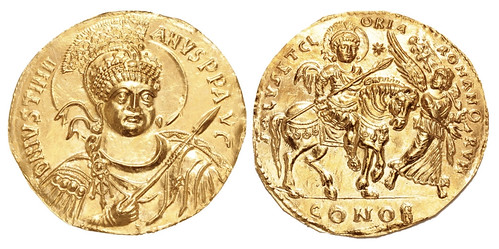
PREV ARTICLE
NEXT ARTICLE
FULL ISSUE
PREV FULL ISSUE
COINS OF JUSTINIAN THE GREATMike Markowitz published a CoinWeek article on the coins of Justinian the Great. Here's an excerpt - see the complete article online. -Editor
Born to a peasant family in what is now North Macedonia about the year 482 CE, Justinian earned his epithet
Justinian I. 527-565. Gold Solidus Alexandria mint. Struck circa 527-538. unpublished in standard references. Possibly only the sixth known. 22mm, 4.45 g. Image: CNG.
Among the rarest collectible gold coins of Justinian are solidi minted at Alexandria in Egypt. These are distinguished by the mint mark ALEXAOB. The
An enigmatic and poorly understood group of gold coins are the
Justinian I. 527-565. Pair of Gilt Electrotypes of Constantinople mint 36 Solidi Medal. Made from the original sulfur cast in the British Museum of the now lost original from the Bibliothèque Nationale de France. Image: CNG.
Justinian's most spectacular coin no longer exists. This gold medallion of 36 solidi was 85 mm (3.35 inches) in diameter and would have weighed about 162 grams (5.2 troy ounces!) when it was struck.
Created as a presentation piece for high officials, it celebrates the reconquest of North Africa from the Vandals in 534. On the reverse, the winged figure of Victory leads a horse ridden by the emperor in military garb. The inscription SALVS ET GLORIA ROMANORVM hails the
To read the complete article, see:
Wayne Homren, Editor The Numismatic Bibliomania Society is a non-profit organization promoting numismatic literature. See our web site at coinbooks.org. To submit items for publication in The E-Sylum, write to the Editor at this address: whomren@gmail.com To subscribe go to: https://my.binhost.com/lists/listinfo/esylum All Rights Reserved. NBS Home Page Contact the NBS webmaster 
|


